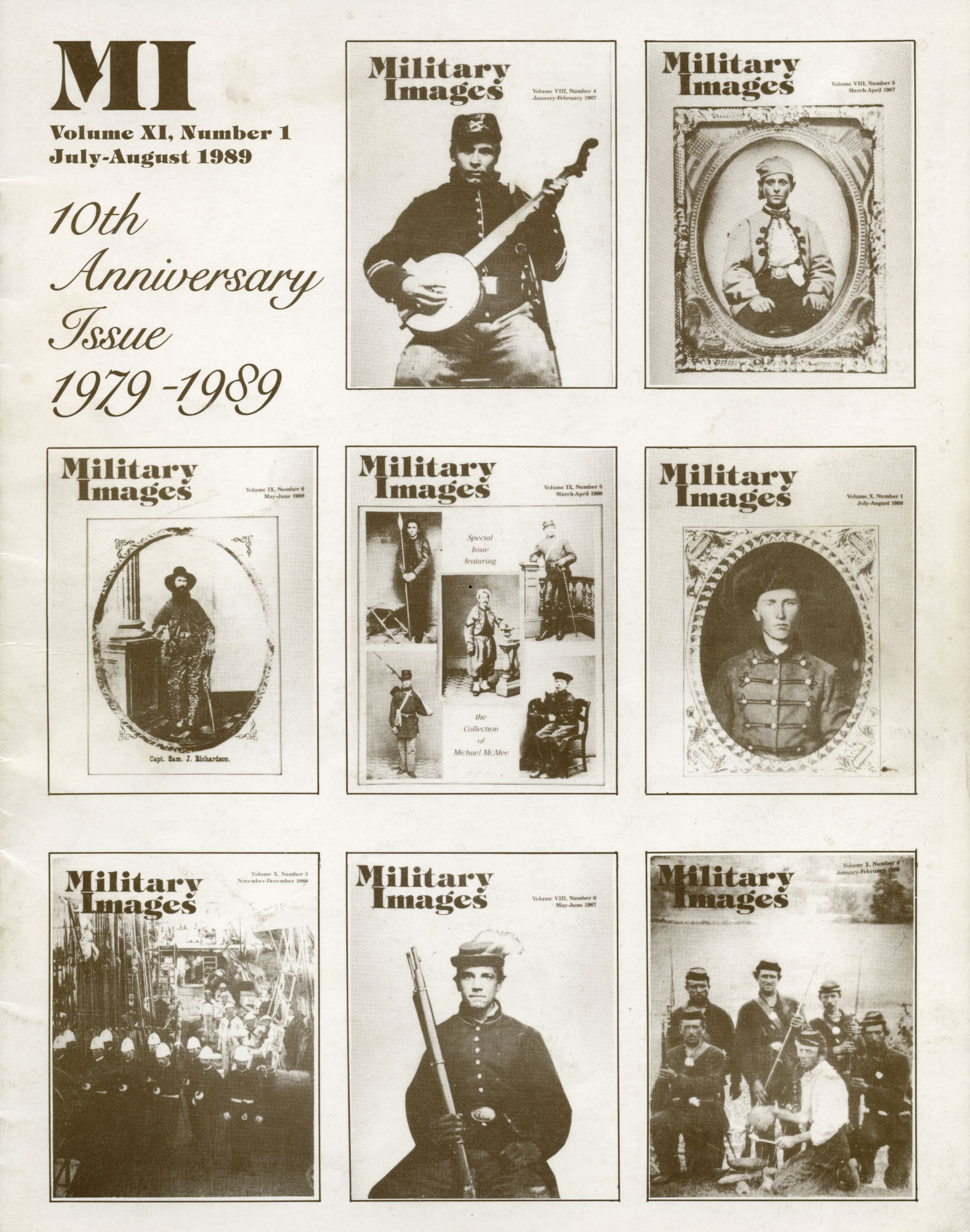
The complete issue
Vol. XI, No. 1
(32 pages)
Print edition: Visit our store to check availability
Digital edition: Visit JSTOR.org to purchase
Subscribe to MI
Explore the MI Archives: Browse | Advanced search | Tutorial
Inside
Cover image
A selection of covers from the past five years is featured.
Editor’s Desk (p. 1)
The editor observes the 10th anniversary of the magazine by thanking subscribers and contributors for their generosity, and offering an extended Stragglers section to display some of the best images from private collectors.
Mail Call (p. 2)
The letters to the editor include congratulations on the 10th anniversary with the comment, “MI is the only magazine of its kind and it certainly fills a need in in the military collecting field.” Also, more comments about Dave Mark’s Marylander issue.
Passing in Review (p. 3)
Six publications are mentioned: The Illustrated Confederate Reader (Harper & Row) by Rod Gregg, Soldiers Blue and Gray (University of South Carolina Press) by James I. Robertson, Two Great Rebel Armies (University of North Carolina Press) by Richard M. McMurray, Photographer on an Army Mule (University of Oklahoma Press) by Maurice Frank with Casey Barthelmess, and two new periodicals of note: Company Front, the newsletter of the 26th Regiment North Carolina Troops, and The Civil War News (revamped from the Civil War Book Exchange).
What Happened To This Man’s Navy? A brief history of Yeomanettes by John A. Stacy (pp. 4-7)
A 1917 authorization to enlist women as Yeoman led to a massive influx of young ladies to perform the traditional duties of this rank, and free up men to fight on the front lines. Portraits of identified yeomen include Lucy and Sydney Burleson, Mary B. Davidson, Edith R. Barrow and Mrs. E. DuBerry Sutherland.
Uncommon Soldiers (pp. 8-15)
In the introduction to this collection of images and personal accounts, the author declares, “Vignette portraits of individuals whose contributions made nineteenth century military life more colorful, to say the least. Some were scoundrels, some were heroes, all were Americans. Featured stories include Col. Myron Beaumont of the 1st New Jersey Cavalry, Sarah Malinda “Sam” Blaylock of the 26th North Carolina Troops, Maj. Levi Twiggs of the U.S. Marine Corps, Pvt. Amos Dalton of the Hampton Legion Infantry, Capt. Ezra Havens of the Mississippi Marine Brigade and Sgt. Harlan Cobb of the U.S. Engineers.
Americans All? A photo mystery game from Anthony Gero (pp. 16-17)
A group of 10 military portraits that date from 1870-1900 are featured. The goal: Guess which are American soldiers and which are not.
Military Imagery, An album of photographs from the collections of our readers (pp. 18-27)
A who’s who of collectors includes Donald Bates, Randy Beck, Michael Bremer, Jerry Coody, George Cress, Norman Delaney, John Ertzgaard, Al Fleming, Scotty Fritts, Ed Frutchey, Anthony Gero, William Gladstone, Brooks Hamm, Randall Hawk, Howard Hoffman, Lee Joyner, Robert Kotchian, Steven Lister, Terry O’Leary, Roy Mantle, L.B. Paul, Paul Reeder, Stephen Rogers, Bill Roll, Martin Schoenfeld, William Schultz, John Sickles, William Styple, David Sullivan, Steve Sullivan, John Wernick, Kean Wilcox and Donald Wisnoski. A total of 45 images are featured. Some are identified: Allen P. Hamm of the C.S. Marines, Capt. Jeremiah Rees of the Pennsylvania Militia, Michajah Berry of Mississippi, Confederate navy Lt. John MacIntosh Kell of the Sumter and Alabama, Boatswain’s Mate James Gurney of the U.S. flagship Severn, Lt. Edmund Reed of the Confederate vessel Stonewall, Randolph Axson of the 2nd Company, Washington Artillery of New Orleans, Union Gen. Alexander Asboth and Sgt. George Williams of the 146th New York Infantry.
Uniforms & History by Michael J. McAfee (pp. 28-29)
In “Fourth Battalion of Rifles, Massachusetts Militia 1860-1861,” McAfee explores the history of this Boston militia group that became the nucleus of the 13th Massachusetts Infantry during the Civil War. Two portraits illustrate the text, Sgt. Sigourney Wales and 2nd Lt. Augustus N. Sampson.
Posing for the Carte de Visite Photograph by Henry Deeks (p. 30)
Described as “an article about style,” the author asserts that carte de visite subjects appeared more casual than the more formal poses seen in earlier images. As a result, the individuality of the subjects is more pronounced. Five images illustrate the text, A.A.E. Disderi, who invented the carte de visite, French politician Comte Frederic Alfred Pierre de Falloux, Capt. Benjamin W. Crowninshield of the 1st Massachusetts Cavalry, 2nd Lt. Francis Washburn of the 1st Massachusetts Cavalry and 1st Lt. Henry May Bond of the 20th Massachusetts Infantry.
Sutlers’ Row (pp. 31-32)
Back cover
More MI covers.









































